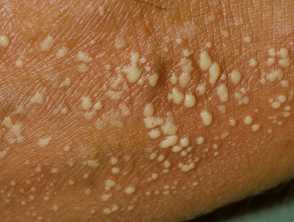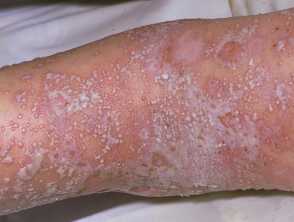What is generalised pustular psoriasis?
Generalised pustular psoriasis (GPP) is a rare, severe form of pustular psoriasis. It is characterised by recurrent flares of widespread sterile pustules with erythematous, painful skin. GPP can be associated with systemic inflammation including fevers and/or hepatic, gastrointestinal, musculoskeletal, renal, or pulmonary involvement.
It is also known as von Zumbusch psoriasis.
Generalised pustular psoriasis
Who gets generalised pustular psoriasis?
GPP can appear in any age group, although is most common in adults between 40–50 years old and is unusual in children. The age of onset is often earlier in patients with a family history of psoriasis, or with a homozygous interleukin 36 (IL-36) receptor antagonist (IL36RN) gene mutation.
Females are generally more likely to be affected, although, for paediatric onset between 3–16 years of age, a male predominance has been reported.
GPP can also affect pregnant women, which is termed impetigo herpetiformis, and is associated with increased maternal and fetal morbidity.
Although GPP is distinct from plaque psoriasis, the two conditions are strongly associated with one another, making concurrent or previous plaque psoriasis a significant risk factor for developing GPP.
What causes generalised pustular psoriasis?
The exact pathogenic mechanisms are not fully established. However, GPP is associated with a combination of genetic and environmental risk factors.
Genetic predispositions
Several genetic mutations are associated with GPP, including homozygous and heterozygous mutations in genes involved in the regulation of immune and inflammatory pathways, such as:
- IL36RN (interleukin 36 receptor antagonist) — homozygous or compound heterozygous mutations are associated with GPP not accompanied by plaque psoriasis
- CARD14 (caspase recruitment domain-containing protein 14) — significant risk for GPP with plaque psoriasis
- AP1S3 (adaptor-related protein complex 1 subunit sigma 3)
- MPO (myeloperoxidase)
- SERPINA3 (Serpin peptidase inhibitor clade A member 3).
Genetic screening for GPP may potentially be available in future.
Environmental risk factors
Use of (or tapering/stopping) various medications may be associated with GPP, such as:
- Analgesics: non-steroidal anti-inflammatory drugs (NSAIDs), morphine
- Anti-hypertensives: ramipril, diltiazem
- Antimicrobials: amoxicillin, pristinamycin, sulfonamides, terbinafine
- Antiplatelet agents: aspirin, clopidogrel
- Other medications including rituximab, lithium, potassium iodide, progestins, and hydroxychloroquine
- Topical agents: topical calcipotriol and steroid combination, topical coal tar
- Paradoxical reaction to tumour necrosis factor (TNF)-alpha inhibitors and ustekinumab (see paradoxical psoriasis)
- Abrupt withdrawal of systemic corticosteroids or ciclosporin
- Vaccinations, including against COVID-19 and H1N1 (swine flu).
Infections:
- Trichophyton rubrum (dermatophyte fungus that can cause fungal nail and skin infections)
- Cytomegalovirus
- Streptococcal species
- Varicella-zoster virus (chickenpox and shingles)
- Epstein-Barr virus.
Other risk factors:
- Hypocalcaemia (can be secondary to hypoparathyroidism)
- Ultraviolet radiation from sunlight, and sunburns
- Stem cell transplantation
- Emotional stress
- Menstruation
- Pregnancy.
What are the clinical features of generalised pustular psoriasis?
Cutaneous features
- Inflammation (redness, swelling, tenderness, itch) develops initially, usually in areas of large skinfolds.
- Within 2–3 hours, 2–3mm sterile non-follicular pustules appear, which then converge to form ‘lakes’ of pus. The trunk and limbs are most commonly affected.
- Over the following days to weeks, pustules dry out and usually resolve with residual erythema and desquamation, or may evolve into erythrodermic psoriasis.
- Lesions tend to regress without sequelae, although hypertrophic scars or keloids may occur.
- GPP is characterised by recurrent acute flares; successive crops of pustules may appear and erupt every few days or weeks.
Non-cutaneous features
- Systemic — fatigue, malaise, fever, headache, tremors, anorexia, nausea, tachycardia.
- Mucosal — cheilitis, geographic or fissured tongue.
- Ocular — conjunctivitis, iritis, uveitis.
- Bone and joint — arthritis, osteomyelitis.
- Gastrointestinal — jaundice, epigastric tenderness.
- Other — nail abnormalities, lower limb oedema.
How do clinical features vary in differing types of skin?
The varying clinical presentation of GPP between differing skin types is not well documented, mainly due to the rarity of the disease. Erythema can be under-recognised in skin of colour, and therefore the severity of inflammation can be underestimated.
What are the complications of generalised pustular psoriasis?
Complications of acute skin failure include:
- Bacteraemia/septicaemia
- Fluid loss with hypovolaemia
- Impaired thermoregulatory control
- Metabolic disturbance.
Other potential complications of GPP:
- Peripheral neuropathy
- Enteropathy
- Malabsorption of nutrients and medications
- Disturbed protein and electrolyte balance
- Renal impairment
- Acute respiratory distress syndrome
- Pancreatitis
- Neutrophilic cholangitis leading to cholestasis
- Cardiac failure.
Such complications can be fatal. Death can result from cardiorespiratory failure during the acute eruptive phase of generalised pustular psoriasis, so it is essential to treat it as early as possible. Older patients are at particularly high risk.
Maternal GPP can result in foetal abnormalities, preterm birth, placental insufficiency, and neonatal death.
How is generalised pustular psoriasis diagnosed?
GPP can be a diagnostic challenge due to its rarity, its heterogeneous cutaneous and extracutaneous symptomatology, its similarity to other conditions such as acute generalised exanthematous pustulosis, and the lack of standardised international diagnostic criteria.
According to the 2018 Japanese guidelines, a definitive diagnosis of GPP can be made in patients with all four of the following features:
- Systemic symptoms such as fever and fatigue
- Extensive or systemic flushing accompanied by multiple sterile pustules that can coalesce into lakes of pus
- Neutrophilic subcorneal pustules, histopathologically characterised by Kogoj’s spongiform pustules
- Repeated recurrences of these clinical and histopathological findings.
GPP would be diagnosed if all four of the above features were present and would be suspected in patients with features 2 and 3.
Abnormal laboratory tests may include:
- Leukocytosis, lymphopenia
- Elevated:
- Erythrocyte sedimentation rate (ESR)
- C-reactive protein (CRP)
- Urea
- Creatinine
- Liver enzymes (AST, ALT)
- Plasma globulins (IgG or IgA).
- Positive blood cultures (if secondary bacterial infection)
- Hypoalbuminemia, hypoproteinemia, hypocalcaemia
- Proteinuria.
Skin biopsy may show:
- Superficial (subcorneal) pustules and neutrophilic infiltration — Kogoj’s spongiform pustules are a distinct histopathologic feature
- Parakeratosis
- Acanthosis
- Hyperkeratosis
- Elongated rete ridges
- Reduced stratum granulosum
- Capillary dilation of the papillary dermis
- Munro’s microabscesses.
Diagnostic criteria were also described in the 2017 European Rare and Severe Psoriasis Expert Network (ERASPEN) which can be found here.
What is the differential diagnosis for generalised pustular psoriasis?
- Acute generalised exanthematous pustulosis
- Subcorneal pustular dermatosis
- Annular pustular psoriasis
- Dermatitis with secondary infection
- Pemphigus foliaceus
- Pustular miliaria
- Pustular erythema multiforme
- Generalised pustular drug eruptions
- IgA pemphigus
- Dermatitis herpetiformis
What is the treatment for generalised pustular psoriasis?
GPP is severe, and complications can be life-threatening. It should be treated promptly and usually hospitalisation is needed. Intensive care support may be necessary.
General measures
- Emollients and moisturisers.
- Intravenous fluids and electrolytes.
- Analgesia.
- If pregnant, careful monitoring of mother and foetus.
Specific measures
- Topical agents:
- Calcipotriol
- Tacrolimus
- Mild potency steroids, eg, triamcinolone.
- Phototherapy — usually in combination with systemic agents.
- Antibiotics in the case of secondary bacterial infection.
- Non-biologic agents:
- Ciclosporin
- Methotrexate
- Oral retinoids (acitretin)
- Mycophenolate
- Less commonly — apremilast, hydroxyurea, colchicine, dapsone.
- Biologic agents:
- TNFα antagonists — adalimumab, infliximab, certolizumab, etanercept
- Interleukin 17 (IL-17) antagonists — brodalumab, secukinumab, ixekizumab, bimekizumab
- Interleukin 23 (IL-23) and 12 (IL-12) antagonists — guselkumab, risankizumab, ustekinumab
- Interleukin 1 (IL-1) antagonists — canakinumab, gevokizumab
- Interleukin 36 (IL-36) antagonists — spesolimab. Imsidolimab is currently under investigation.
What is the outcome of generalised pustular psoriasis?
GPP is an incurable condition, with an unpredictable and variable course.
Although treatment aims to prevent and reduce the frequency and duration of flares, most patients have recurrent disease. The time interval between flares ranges from weeks to years, and the severity of flares is also fluctuant. There may or may not be complete regression of lesions after flares, and symptoms have been reported to persist between flares in ~80% of cases.
Data on mortality rates are limited, but have been reported between 3–7%. Older patients likely have a poorer prognosis than younger patients due to comorbidities and systemic complications.

